#plant physiology and development
Text
Carl Linnaeus was the first to describe a naturally occurring mutant of toadflax (Linaria vulgaris) that converted the bilaterally symmetrical flower to a radially symmetrical form (Figure 20.31).

"Plant Physiology and Development" int'l 6e - Taiz, L., Zeiger, E., Møller, I.M., Murphy, A.
#book quotes#plant physiology and development#nonfiction#textbook#peloria#mutants#mutation#toadflax#linaria vulgaris#carl linnaeus#bilateral symmetry#radial symmetry#cycloidea#dna#methylation
26 notes
·
View notes
Text
Other specialized epidermal cells, such as lithocysts, bulliform cells, silica cells, and cork cells (Figure 19.9), are found only in certain groups of plants and are not studied as well.

"Plant Physiology and Development" int'l 6e - Taiz, L., Zeiger, E., Møller, I.M., Murphy, A.
#book quote#plant physiology and development#nonfiction#textbook#plant cells#epidermis#epidermal cells#lithocysts#bulliform cells#silica cells#cork cells#maize#corn#zea mays#ammophila#ficus#grass#pavement cells#guard cells#microscopy
7 notes
·
View notes
Text
Plant signal transduction mechanisms may be relatively rapid or extremely slow (Figure 15.1)
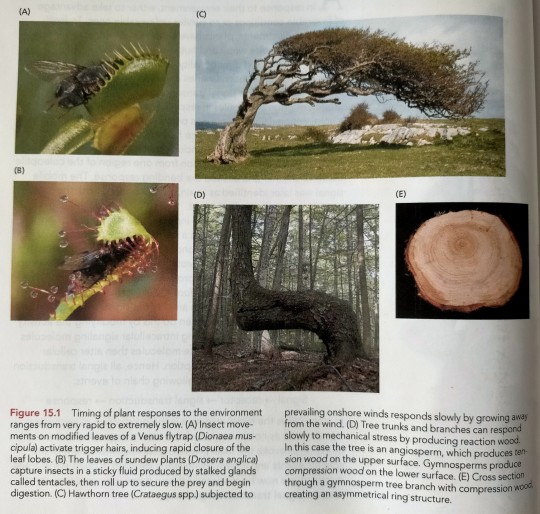
"Plant Physiology and Development" int'l 6e - Taiz, L., Zeiger, E., Møller, I.M., Murphy, A.
#book quotes#plant physiology and development#nonfiction#textbook#signals#transduction#environmental response#venus fly trap#dionaea#dionaea muscipula#sundew#drosera#drosera anglica#carnivorous plants#hawthorn#crataegus#stress#mechanical stress#environmental stress#wood
23 notes
·
View notes
Text
An example of induced aerenchyma occurs in maize (corn; Zea mays) (Figure 24.19).
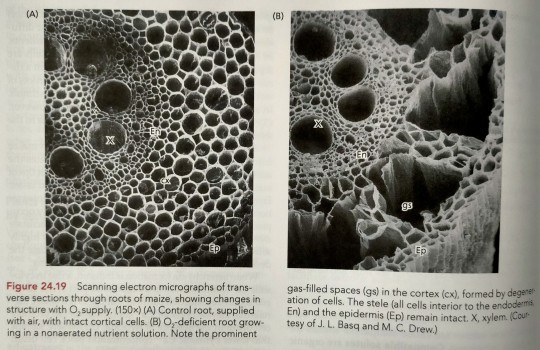
"Plant Physiology and Development" int'l 6e - Taiz, L., Zeiger, E., Møller, I.M., Murphy, A.
#book quotes#plant physiology and development#nonfiction#textbook#corn#maize#zea mays#trypophobia#scanning electron micrograph#microscopy#aerenchyma#plant cells
8 notes
·
View notes
Text
The systemic production of proteinase inhibitors in young tomato plants is triggered by a complex sequence of events (Figure 23.20):
Wounded tomato leaves synthesize prosystemin, a large (200 amino acids) precursor protein.
Prosystemin is proteolytically processed to produce the short (18 amino acids) polypeptide DAMP called systemin.
Systemin is released from damaged cells into the apoplast.
In adjacent intact tissue (phloem parenchyma), systemin binds to a pattern recognition receptor on the plasma membrane.
The activated systemin receptor becomes phosphorylated and activates a phospholipase A2 (PLA2).
The activated PLA2 generates the signal that initiates JA biosynthesis.
JA is then transported through the phloem to systemic parts of the plant by an unknown mechanism.
JA is taken up by target tissues and activates the expression of genes that encourage proteinase inhibitors.

"Plant Physiology and Development" int'l 6e - Taiz, L., Zeiger, E., Møller, I.M., Murphy, A.
#book quotes#plant physiology and development#nonfiction#textbook#proteinase#tomato#solanum lycopersicum#prosystemin#amino acids#polypeptide#damage associated morning patterns#damp#apoplast#phloem#parenchyma#phosphorylation#pla2#phospholipase a2#ja#jasmonic acid#plant cells#vascular tissue#companion cells#plasmodesma
8 notes
·
View notes
Text
Similarly, grafting a shoot from the LDP Petunia hybrida onto a stock of the cold-requiring biennial henbane (Hyoscyamus niger) caused the latter to flower under long days, even though it was nonvernalized (Figure 20.18).
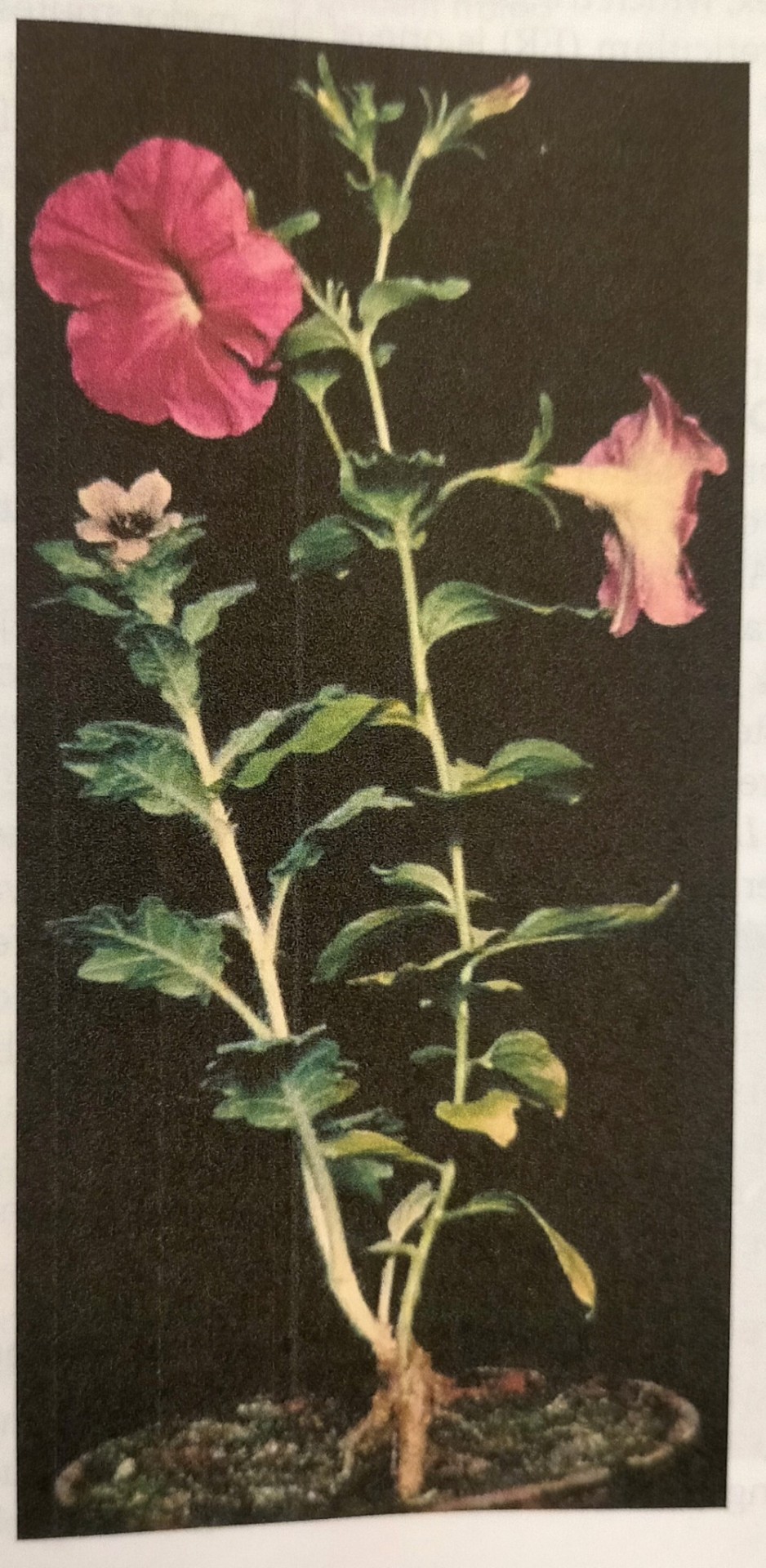

"Plant Physiology and Development" int'l 6e - Taiz, L., Zeiger, E., Møller, I.M., Murphy, A.
#book quotes#plant physiology and development#nonfiction#textbook#ldp#long day plant#grafting#flowering#biennial#petunia hybrida#henbane#hyoscyamus niger#vernalization
9 notes
·
View notes
Text
In fact there are remarkable similarities in the way electron flow is coupled to proton translocation in chloroplasts, mitochondria, and purple bacteria (Figure 7.31).

"Plant Physiology and Development" int'l 6e - Taiz, L., Zeiger, E., Møller, I.M., Murphy, A.
#book quotes#plant physiology and development#nonfiction#textbook#purple bacteria#purple#bacteria#chloroplast#mitochondria#photosynthesis#photochemistry#atp#atp synthase#oxidation#reduction#redox#nadp#nadh#ubiquinone
10 notes
·
View notes
Text
The germination of physiologically mature seeds on the mother plant is known as preharvest sprouting and is characteristic of some grain crops when they mature in wet weather (Figure 18.4A). (...) In maize, viviparous (vp) mutants have been selected in which the embryos germinate directly on the cob while still attached to the parent plant, referred to as precocious germination (Figure 18.4B).


"Plant Physiology and Development" int'l 6e - Taiz, L., Zeiger, E., Møller, I.M., Murphy, A.
#book quotes#plant physiology and development#nonfiction#textbook#germination#preharvest sprouting#wet weather#maize#corn#zea mays#precocious germination#viviparous#vivipary#mutation#mutants#vp#wheat#triticum aestivum#xanthoxin#aba#abscisic acid
5 notes
·
View notes
Text
Arbuscular mycorrhizal fungi develop, outside the root of their host, a highly branched system (mycelium) of hyphae (fine filamentous structures 2 to 10 μm in diameter) that explores the soil (Figure 5.12).

"Plant Physiology and Development" int'l 6e - Taiz, L., Zeiger, E., Møller, I.M., Murphy, A.
#book quote#plant physiology and development#nonfiction#textbook#arbuscular fungi#mycorrhizae#mycorrhizal network#fungus#symbiotic relationship#mycelium#soil science#plant growth#roots#glomus mosseae#cherry plum#prunus cerasifera
7 notes
·
View notes
Text
The life cycles of parasitic nematodes begins when dormant eggs recognize specific compounds secreted by the plant root (Figure 23.33). (...) As a result, the cell walls break down and neighboring cells are incorporated into a syncytium (see Figure 23.33A). (...) Roots infected by root knot nematodes form large cells, resulting in the establishment of the characteristic knot or gall, which also remains in close contact with the vasculature and provides the nematode with nutrients (see Figure 23.33B).
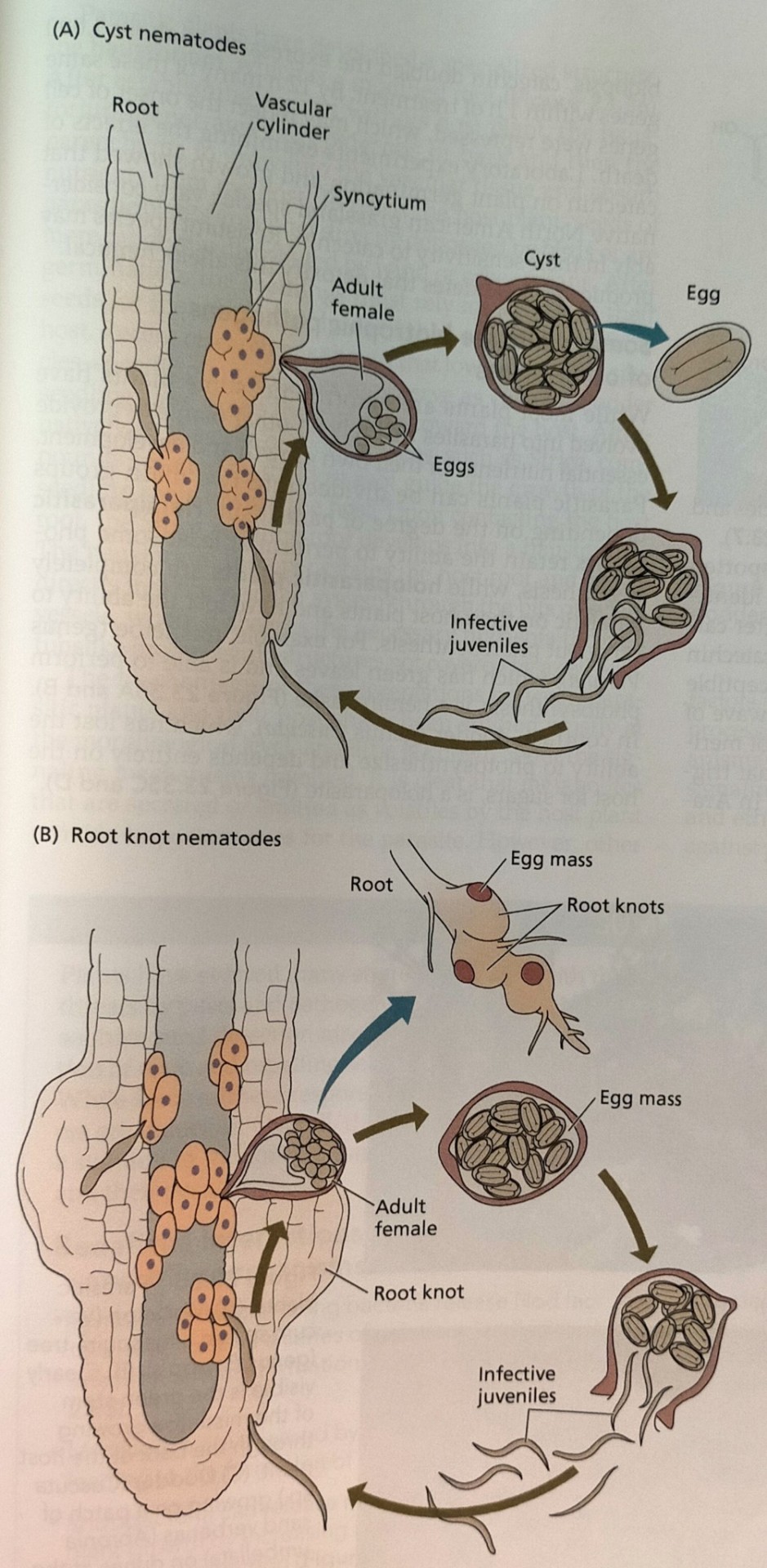
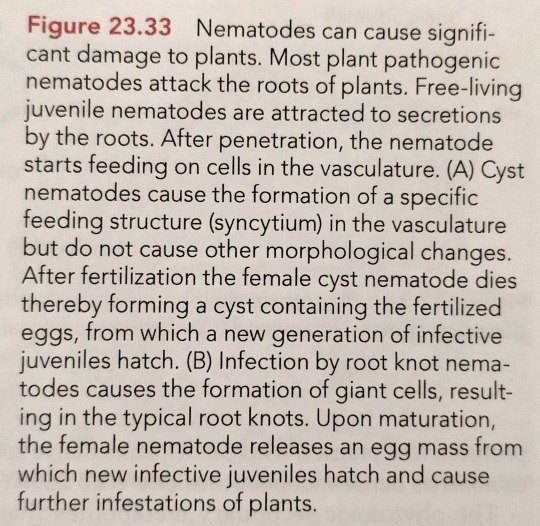
"Plant Physiology and Development" int'l 6e - Taiz, L., Zeiger, E., Møller, I.M., Murphy, A.
#book quotes#plant physiology and development#nonfiction#textbook#life cycle#parasitic#nematodes#dormant#eggs#plant cells#cell walls#syncytium#roots#plant roots#infection#root knot#gall#vasculature
3 notes
·
View notes
Text
After vernalization, this gene is epigenetically switched off for the remainder of the plant's life cycle, permitting flowering in response to long days to occur (Figure 20.16).

"Plant Physiology and Development" int'l 6e - Taiz, L., Zeiger, E., Møller, I.M., Murphy, A.
#book quote#plant physiology and development#nonfiction#textbook#vernalization#epigenetics#life cycle#flowering#flc#flowering locus
3 notes
·
View notes
Text
Some representative examples of seeds from eudicots and monocots are shown in Figure 18.1. (...) Instead, the perisperm and storage cotyledons serve as the main sources of nutrients during germination (see Figure 18.1). (...) Specialized embryonic structures peculiar to the grass family include the following (see Figure 18.1):
The single cotyledon has been modified by evolution to form an absorptive organ, the scutellum, which forms the interface between the embryo and the starchy endosperm tissue.
The basal sheath of the scutellum has elongated to form a coleoptile that covers and protects the first leaves while buried beneath the soil.
The base of the hypocotyl has elongated to form a protective sheath around the radicle called the coleorhiza.
In some species, such as maize, the upper hypocotyl has been modified to form a mesocotyl. During seedling development, the growth of the mesocotyl helps raise the leaves to the soil surface, especially in the case of deeply planted seeds.


"Plant Physiology and Development" int'l 6e - Taiz, L., Zeiger, E., Møller, I.M., Murphy, A.
#book quotes#plant physiology and development#nonfiction#textbook#eudicots#monocots#perisperm#cotyledons#germination#grasses#poaceae#scutellum#coleoptile#coleorhiza#mesocotyl#wheat#onion#runner bean#fenugreek#castor bean#beet#seeds#endosperm#caruncle#radicle
3 notes
·
View notes
Text
The development of the seed plant sporophyte can be broken down into three major stages (Figure 17.2): embryogenesis, vegetative development, and reproductive development. (...) An essential feature of this basic architecture is the presence of apical meristems at the tips of the root and shoot axes (see Figure 17.2), which are key to sustaining indeterminate patterns of vegetative growth.
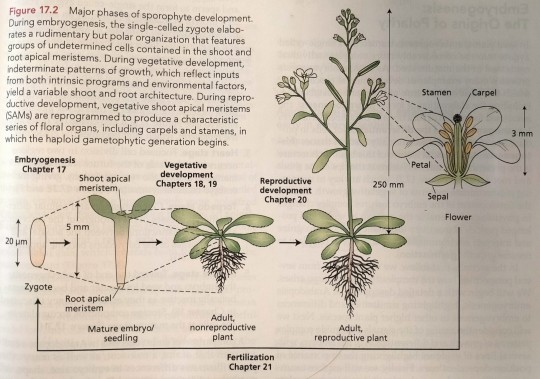
"Plant Physiology and Development" int'l 6e - Taiz, L., Zeiger, E., Møller, I.M., Murphy, A.
#book quotes#plant physiology and development#nonfiction#textbook#plant growth#plant development#indeterminate growth#apical meristem#plant shoots#plant roots#vegetative growth#sporophyte#seed plants#embryogenesis#plant anatomy#flower anatomy#zygote#flower#stamen#carpel#petal#sepal
3 notes
·
View notes
Text
Action potentials have been shown to meditate touch-induced leaflet closure in sensitive plant (Mimosa pudica), as well as the rapid closure (~0.1 s) of Venus flytrap, which occurs when an insect touches the sensitive hairs on the upper sides of the traplike leaf lobes (Figure 15.27A). (...) Since each displacement elicits an action potential (Figure 15.27B), the leaf must have a mechanism for counting action potentials.

"Plant Physiology and Development" int'l 6e - Taiz, L., Zeiger, E., Møller, I.M., Murphy, A.
#book quotes#plant physiology and development#nonfiction#textbook#electrical signaling#action potential#sensitive plant#mimosa pudica#venus fly trap#dionaea muscipula#touch sensitive#bioelectricity
6 notes
·
View notes
Text
A small molecule was identified that could, in the presence of auxin, stimulate tobacco pith parenchyma tissue to proliferate in culture (Figure 15.11A).

"Plant Physiology and Development" int'l 6e - Taiz, L., Zeiger, E., Møller, I.M., Murphy, A.
#book quote#plant physiology and development#nonfiction#textbook#auxin#cytokinin#stimulation#tobacco#pith#parenchyma
3 notes
·
View notes
Text
Conifer resin ducts, which are found in the cortex and phloem, contain a mixture of diverse terpenoids, including bicyclic monoterpenes such as α-pinene, monocyclic terpenes like limonene and terpinolene, and tricyclic sesquiterpines, including longifolene, caryophyllene, and δ-cadinene, as well as resin acids, which are released immediately upon damage to herbivores (Figure 23.11).

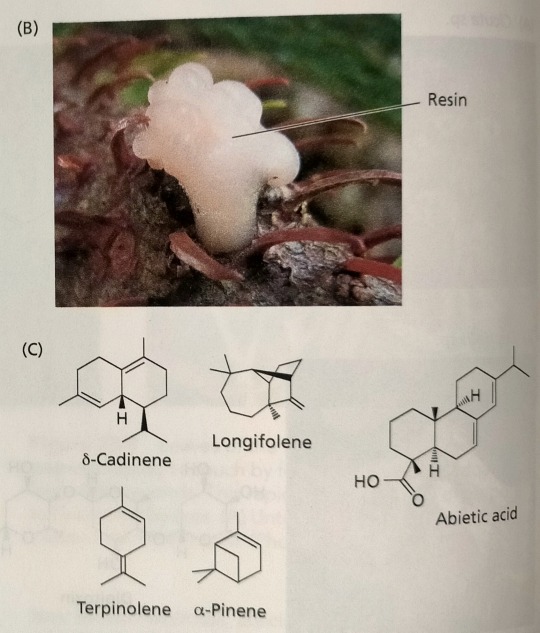
"Plant Physiology and Development" int'l 6e - Taiz, L., Zeiger, E., Møller, I.M., Murphy, A.
#book quotes#plant physiology and development#nonfiction#textbook#conifer resin ducts#cortex#phloem#terpenoid#bicyclic#monoterpene#pinene#alpha pinene#beta pinene#monocyclic#limonene#terpinolene#tricyclic#sesquiterpine#longifolene#caryophyllene#cadinene#delta cadinene#resin acid#herbivores#plant cells
2 notes
·
View notes